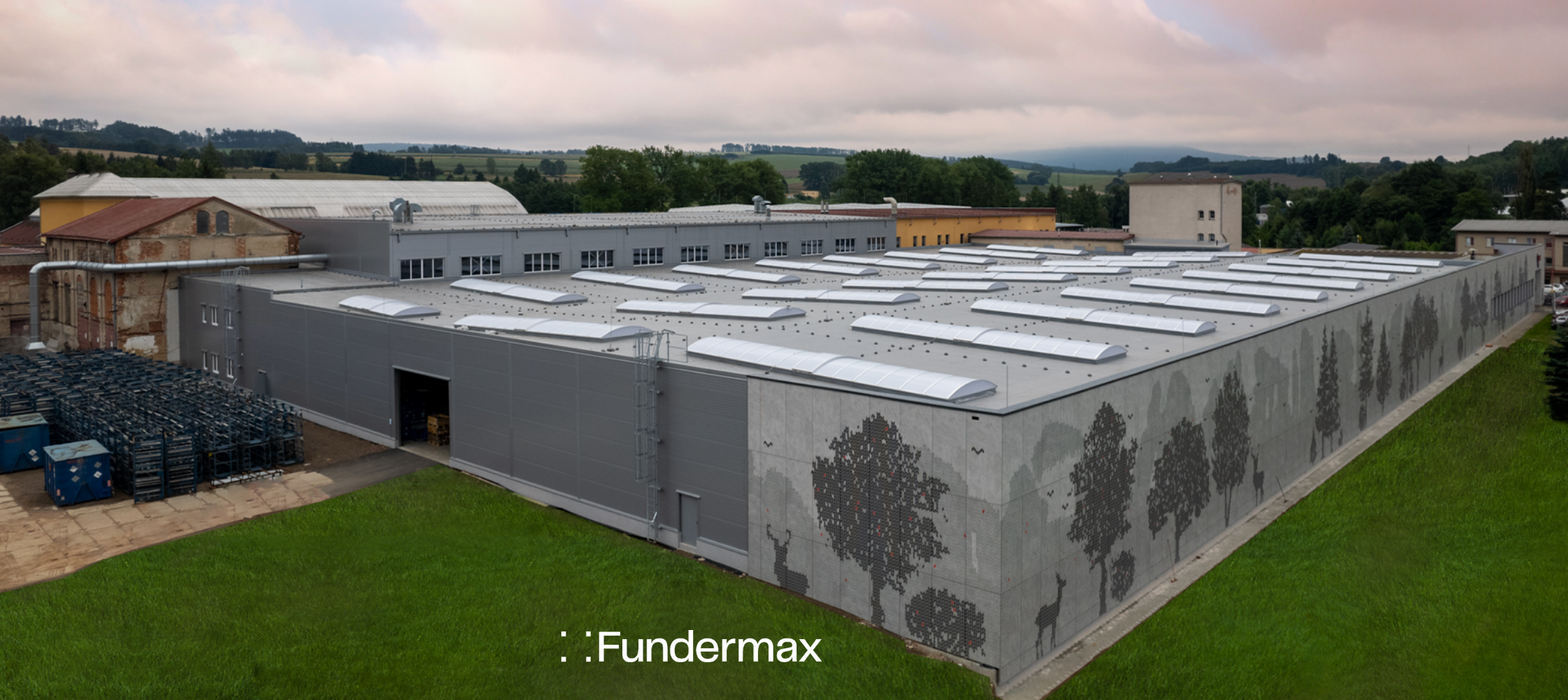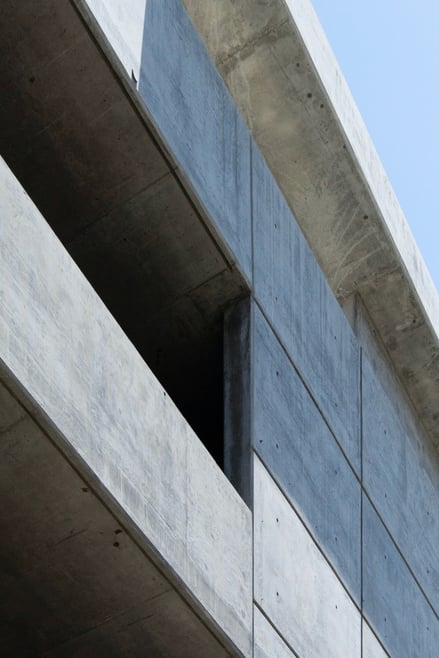
Fiber Cement vs Phenolic Panels: Which is Best For You?
| Last updated August 26, 2025
Fundermax is a global leader in phenolic panel manufacturing, so it goes without saying that we are partial to phenolic panels. Having said that, while we are well-versed in the benefits of phenolic panels, we also know that to provide any helpful measure of comparison between our products and other materials, we must remain familiar with those other materials.
If you are an architect looking into wall panel options, you have likely been comparing fiber cement to phenolic panels for your project. In this article, we will provide a look at fiber cement vs phenolic panels, and specifically, fiber cement vs Fundermax exterior phenolic wall panels.
What Are Fiber Cement Panels?
The specific composition varies depending on the manufacturer, but generally speaking, fiber cement panels are made of water, portland cement (a limestone-based powder common in concrete), silica sand or fly ash, and cellulose fibers.
Fiber cement is different from the cement used to make concrete. The cement in concrete is fiberless and brittle; fiber cement, on the other hand, can bend without cracking thanks to the cellulose fibers that improve the flexibility and resilience of the material. This is essential for manufacturing, transporting, and installing fiber cement siding panels.
Until the 1970s, rather than cellulose fibers, fiber cement used asbestos fibers. Asbestos is a naturally occurring mineral composed of heat-resistant, insulating, flexible fibers and was widely used in construction as an inexpensive way to add strength to cement and other materials. However, we now know that asbestos exposure increases the risk of certain cancers.
This led manufacturers to begin using cellulose instead, which is composed of harmless wood pulp fibers, thereby eliminating the asbestos-related health risks of fiber cement panels. (The use of asbestos house siding in new construction was discontinued in the late 1970s - early 1980s, but it is still present in many older homes, so be cognizant of this when working on a home built before that time, regardless of which new siding material you will use.)
What Are Phenolic Panels?
Like other materials, the specific composition of phenolic panels varies a bit across different phenolic panel manufacturers, but overall, phenolic cladding panels are made using high-pressure and heat to compress layers of kraft paper impregnated with thermosetting resins.
The result is a highly abrasion-resistant architectural panel: solid, compact boards that are durable, long-lasting, and virtually maintenance-free. Phenolic cladding panels are also a sustainable material, and among phenolic panel manufacturers, Fundermax places a particularly high priority on sustainability in our products and business operations.
Another reason that phenolic panels are on the rise is that the material’s strength and sustainability do not require the sacrifice of high design. Phenolic wall panel systems offer virtually endless decor options including colors, textures, fastener systems, and custom printing.

Fiber Cement vs. Phenolic Panels
Below we compare the two products in seven key ways to see where they differentiate to help you decide which is best for your project.
Durability
Phenolic Panels
Phenolic cladding panels are made for durability. Weather-, graffiti-, scratch-, and impact-resistant, a phenolic wall panel system can endure harsh and high-traffic environments without compromising performance or appearance. When comparing fiber cement to Fundermax panels, in particular, it is worth noting that the acrylic surface of Fundermax’s Max Compact Exterior phenolic wall panels is even 5x thicker than comparable phenolic products from other phenolic panel manufacturers.
Fiber Cement Panels
Fiber cement siding panels are strong materials and compared to residential siding materials like wood or vinyl, fiber cement panels offer much greater overall durability. However, when considering the durability of performance and appearance compared to phenolic panels, the inherently increased risks of fiber cement panels chipping, scratching, and showing the damage are worth careful consideration. Some of this can be addressed with maintenance, which we will cover below.
Maintenance & Longevity
Fiber Cement Panels
It is no secret that fiber cement requires more regular maintenance than other siding materials. While it can be a long-lasting material, fiber cement’s longevity comes with great attention to maintenance and upkeep. In addition to regular cleaning (mild soap and water is recommended), repainting will eventually be needed as well.
When a fiber cement panel chips or breaks, patches or replacements will be required. Some manufacturers offer factory-painted siding panels with limited warranties on chipping and peeling, however, many building owners find they need to repaint sooner. Warranties can be quite particular about what is covered, so be sure to thoroughly review any warranties offered and what is (and is not) covered.

Phenolic Panels
While different wall panel materials can be fairly comparable on some points, one of the most recognizable benefits of a phenolic wall panel system over fiber cement (and virtually every other material) is its impressive longevity with minimal maintenance. Phenolic cladding panels will not fade and do not require regular maintenance or cleaning.
Phenolic panels are also nonporous, so if a panel does incur a stain, it can be cleaned by using aggressive solvents like acetone if needed (which cannot be used on the majority of other materials) for simple and thorough cleanup without damaging the panel finish.
Additionally, with the majority of Fundermax decors, if a surface is somehow damaged, with certain fastening systems the panel may be flipped over, reversing the panel instead of replacing it as most of our panels come with double-sided decors. Fundermax backs all of this with an industry-leading 10-year limited warranty, including labor, on our exterior phenolic wall panels.
Versatility & Decors
Fiber cement and phenolic wall panels both have a variety of decor options available, so both materials may have what you need, depending on what you’re looking for.
Phenolic Panels
Phenolic panels have a wide variety of versatile decor options that can match any aesthetic you may need, including woodgrains, metal, stone, solid colors, glitter, abstract, and even custom digital printing.
Fiber Cement Panels
Fiber cement panels normally have a color-matched core, which can be a great benefit if you need it. The downside to this is that fiber cement panels are typically only available in solid colors. Fiber cement is, however, a paintable surface, so if you aren’t pleased with the available colors, you can paint it. (Beware of further increasing your maintenance requirements though.)

Sustainability
Fiber Cement Panels
While the ingredients that make up fiber cement panels are environmentally friendly on their own, the process required to turn those ingredients into fiber cement requires plenty of environmental resources.
Additionally, the weight of the finished material adds to the environmental impact of shipping it. The overall result is that fiber cement panels are not a particularly sustainable material.
Phenolic Panels
Like fiber cement panels, the materials used to make phenolic panels are environmentally friendly on their own, but in order for the final product to truly be sustainable, you must choose a manufacturer that is certified and committed to sustainable operations and to producing sustainable phenolic panels.
Fundermax has a heavy focus on sustainability including several ISO certifications that demonstrate our company-wide commitment to operating in a responsible manner. (These certificates document our energy management, environmental efficiency, and even the safe and healthy internal work environment we provide to our employees.) We are FSC-, PEFC-, and Greenguard-certified, part of the Mindful Materials Library, and our materials contribute to LEED standards.
Ease of Installation
Fiber Cement Panels
The installation brings about a couple of notable risks of fiber cement panels. First, installing fiber cement wall panels and siding requires exceptional adherence to installation instructions in order to avoid moisture concerns.
Also, installers must take special health and safety precautions when installing fiber cement panels as they can contain over 30% Crystalline Silica. Cutting fiber cement panels generates respirable crystalline silica, a known human carcinogen. Inhaling too much silica can lead to silicosis, lung cancer, and COPD.
Installers must use special saw blades, ventilation, and respirators to limit silica inhalation to a safe level during installation. Finally, fiber cement panels can be brittle before they are installed on a wall. Attention must be paid to the types of nails and guns used in order to prevent blowouts at the point of fastening on the panel.
Phenolic Panels
Although installing a phenolic wall panel system is not exactly an amateur DIY project, generally speaking, phenolic panels are recognized for ease of installation. With multiple substrate and fastener options, the installation of Fundermax panels is quite simple and straightforward. For a more thorough look at how to install phenolic panels, see this article.
Cost
Whether you work with phenolic or fiber cement panels, the cost of either material will vary with the quality and brand you choose. There are higher-end and lower-end fiber cement options just as there are higher- and lower-end options among phenolic panel manufacturers.
Here, we will simply point out that a higher or lower price tag correlates with higher or lower quality, and particularly with building materials, the total cost of ownership matters. Yes, higher-end phenolic panels such as Fundermax will be more expensive upfront; and the value will be realized over the long term.
Code Compliance
Both phenolic and fiber cement panels can be widely code-compliant. You will want to check with the manufacturers for their products' additional certifications.
Among phenolic panel manufacturers, Fundermax has consistently led the way regarding code compliance. For example, while many phenolic panels have a standard Class B fire rating, all Fundermax exterior phenolic panels are Class A fire rated and have more NFPA285-compliant assemblies than any other HPL in the market.
Additionally, even before the code adoption of HPL as a specific segment of IBC Chapter 14 (exterior walls), Fundermax invested in a full Intertek CCRR Report for our Max Compact Exterior façade cladding, meeting criteria that remain far beyond the minimum IBC code requirements for high-pressure laminates.
If you are still working through wall panel options, we would love to help. With over a century of experience, we can help you determine when to use phenolic panels – and when another material may be a better fit. Contact Fundermax today for more information.

